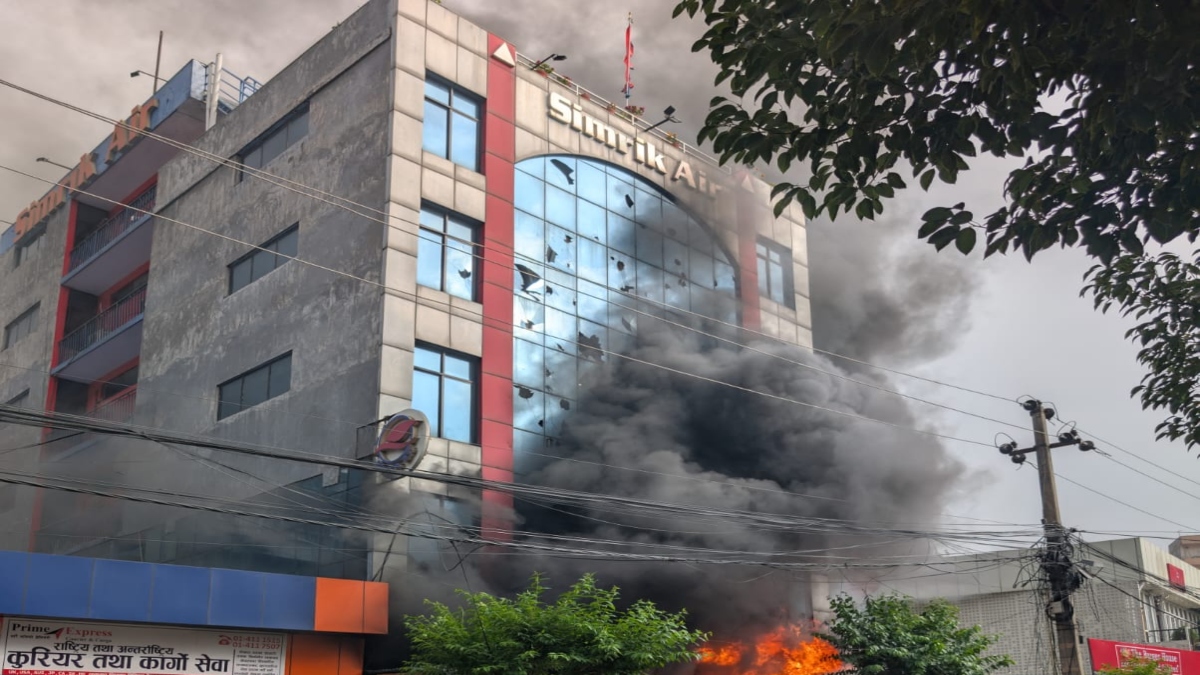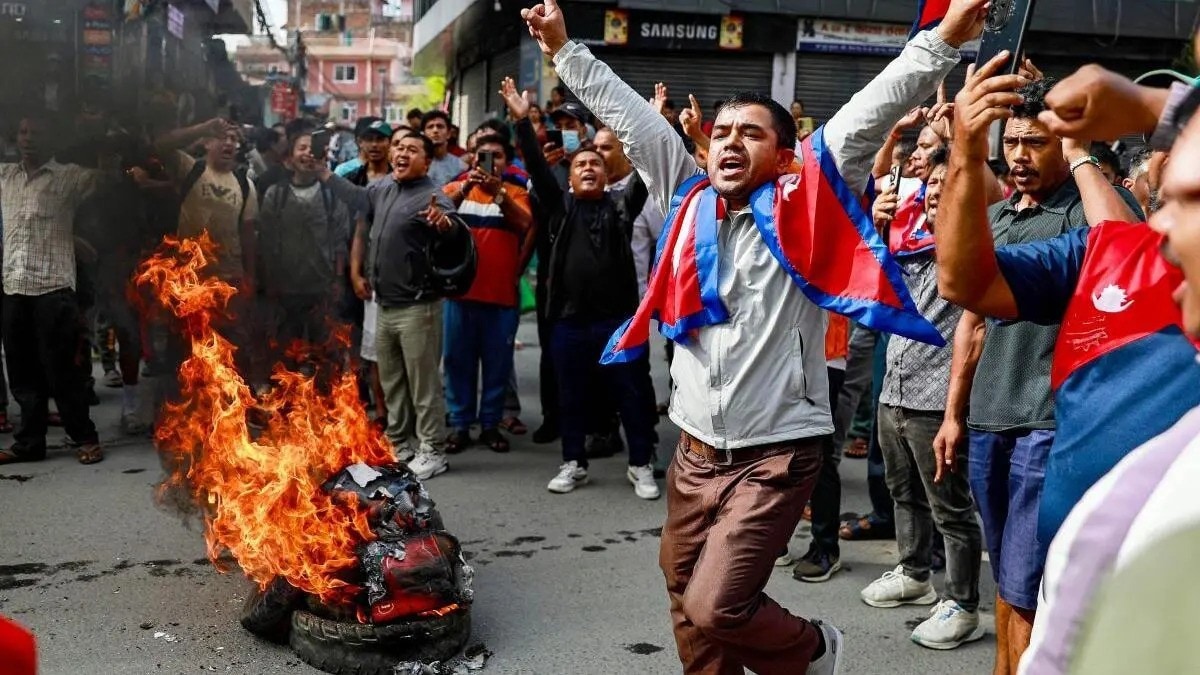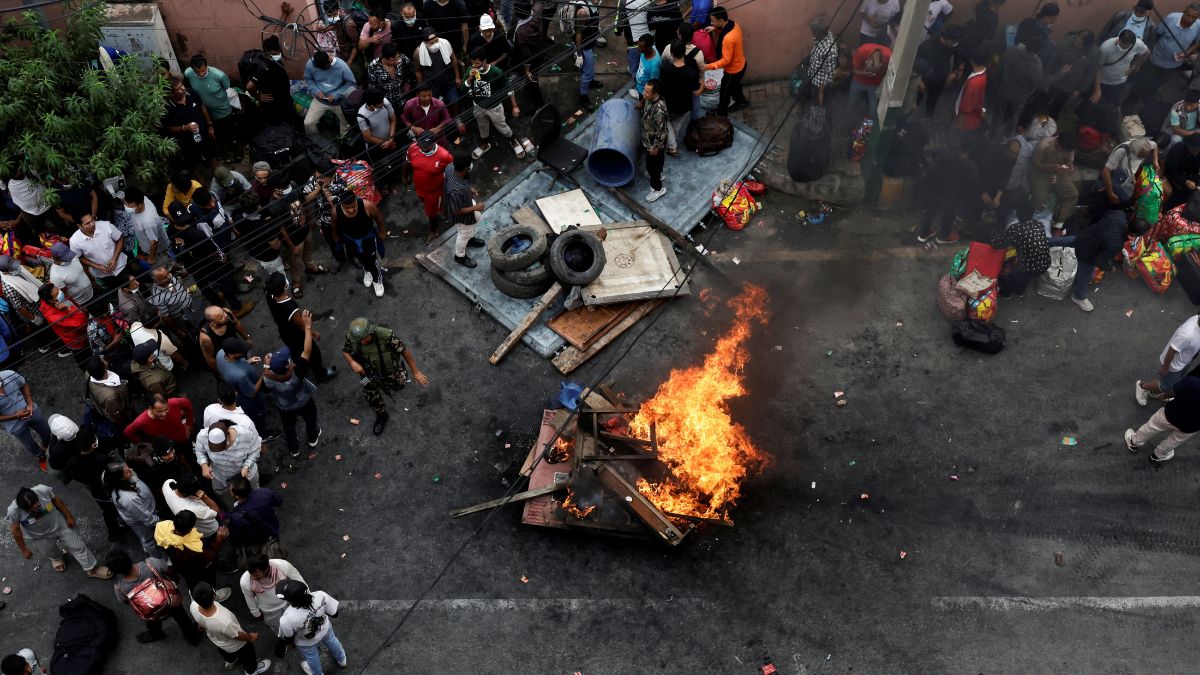The situation in Nepal is extremely serious due to widespread, deadly, and violent protests that have led to the Prime Minister’s resignation and the torching of public and private property. The unrest is primarily driven by widespread public anger over corruption, a struggling economy, and a government-imposed ban on social media platforms like Facebook, WhatsApp, and YouTube. These issues, particularly the ban which was seen as a tool for censorship, ignited protests, most notably among the ‘Gen Z’ leading to violent clashes with police, a high death toll, and the eventual resignation of the Prime Minister.
Click here for Nepal Gen Z Protest LIVE Updates
Gen Z, or the “Zoomer” generation, refers to the young generation born between 1995 and 2010. As the first generation to grow up with the internet and mobile technology, Gen Z is known for being digital natives and tech-savvy, prioritising authenticity, diversity, and pragmatic approaches to issues like climate change and social responsibility.
The government blocked access to major social media platforms after they failed to register and comply with new government oversight requirements, fuelling protests that demanded the ban be lifted. Long-standing frustration with high-level corruption among political figures contributed significantly to the public outcry, with images of extravagant spending by the elite highlighting the economic hardship faced by ordinary citizens.
A history of political instability, coupled with a perceived lack of responsiveness from the government, has contributed to growing dissatisfaction, especially among the younger generation. The violent response from security forces to the initial anti-ban protests, resulting in numerous deaths and injuries, only intensified the anger and further pressured the government. The violent clashes between protesters and police resulted in at least 19 deaths and hundreds of injuries.
Impact Shorts
More ShortsThe massive protests and subsequent deaths led to the resignation of Prime Minister KP Sharma Oli, who stated his decision was to “facilitate a solution” to the political crisis. Following the Prime Minister’s resignation, the government lifted the ban on social media, though the underlying causes of the unrest remain.
Unrest in Nepal is a matter of significant concern for India, due to shared security, economic, and strategic interests. India closely monitors any destabilizing events and has historically been involved in and influenced by Nepal’s political developments. India’s Ministry of External Affairs has called for restraint and dialogue. In addition, India has increased security along the Indo-Nepalese border to prevent any spillover of unrest. The long, open border between India and Nepal is a security risk during times of turmoil. Increased vigilance is required to prevent the movement of illicit goods, criminal elements, or anti-India forces.
The Ministry of External Affairs (MEA) stated, “As a close friend and neighbour, we hope that all concerned will exercise restraint and address any issues through peaceful means and dialogue.” The MEA confirmed it was “closely monitoring the developments" and urged Indian nationals in Nepal to “exercise caution and adhere to the steps and guidelines issued by the Nepali authorities”.
India and China are in a high-stakes competition for influence in Nepal. During periods of instability, the power vacuum can be exploited by China, especially through infrastructure projects and economic initiatives. A Nepal that tilts too far towards China is a strategic worry for India. Political leaders in Nepal have at times used nationalist rhetoric against India to consolidate support. Such actions can jeopardise bilateral relations and India’s position in the country.
The ongoing unrest in Nepal also has economic implications for both Nepal and India. Political instability can disrupt trade, transportation, and connectivity projects between the two countries, which is economically detrimental to both. Indian-funded infrastructure and hydropower projects in Nepal can be stalled or jeopardised by civil unrest. India and Nepal share several important river systems. Political instability can impede cooperation on water resources, including crucial hydropower and irrigation projects.
India has historically favoured democratic stability in Nepal. Continued political upheaval and fragile governance can undermine the democratic process and hinder effective policymaking. Nepal has had more than 10 governments since its monarchy was abolished in 2008, a sign of ongoing political fragility. The Himalayan country is a key part of India’s “Neighbourhood First” policy. Instability in a bordering country can have a regional ripple effect.
The latest instability adds to a history of political volatility in Nepal, which has seen 13 governments since 2008. The recent protests, led by young people, were triggered by a temporary ban on social media, but they also reflect deep-seated public anger over alleged government corruption and ineffective governance. India’s primary interests in Nepal involve maintaining regional stability, preventing Nepal from becoming a platform for anti-India activities, ensuring its economic interests are met through hydropower and trade, and securing its own border from potential threats. These interests stem from Nepal’s strategic location as a buffer between India and China and its open border, which allows for free movement of people but also poses security challenges.
India’s economic interests
The violent anti-government protests in Nepal, culminating in Prime Minister Oli’s resignation, have raised significant concerns for India’s economic interests. India has vital economic ties with Nepal, relying on the landlocked nation for cross-border trade, energy, and stability against increasing Chinese influence.
There are risks to bilateral trade. The current unrest threatens to disrupt the crucial trade corridor that connects Nepal with India and the rest of the world, and there are fears of the disruption of supply chains. India is Nepal’s largest trade partner and accounts for a significant portion of its imports, including petroleum products, vehicles, machinery, and food. Political instability can lead to delays at border crossings, including major transit points like Raxaul-Birgunj and Sunauli-Bhairahawa, causing supply chain disruptions that harm both Indian exporters and Nepali consumers.
There could also be an impact on Indian investment. With over 150 Indian ventures operating in Nepal, accounting for more than 35 per cent of its total Foreign Direct Investment (FDI), ongoing instability creates an unfavourable investment climate. Indian companies in sectors like manufacturing, telecommunications, and power could suffer financial losses and face project delays.
There are also serious threats to energy cooperation. Recent developments have seen significant progress in India-Nepal energy relations, which are now at risk. Numerous cross-border hydropower projects are in development or being planned, with large-scale investment from Indian firms. The new political uncertainty could jeopardise these projects, stalling construction and undermining India’s goal of securing up to 10,000 MW of power from Nepal over the next decade. Joint ventures between Indian and Nepali entities to develop cross-border transmission lines, such as the Dododhara-Bareilly and Inaruwa-Purnea lines agreed to in April 2025, may face delays.
There is also the threat to regional stability and India’s geopolitical interests. Nepal’s internal political strife has broader geopolitical implications for India. The ongoing instability could create an opening for China to increase its economic and political influence in Nepal. India has been actively engaged in Nepal to counter Beijing’s growing presence, particularly in the infrastructure and energy sectors. A prolonged state of unrest in Nepal could destabilise the long and open border shared with India, facilitating cross-border criminal activities, including smuggling and other security threats. In response to the recent protests, India has already heightened security measures along the border.
There will also be a negative impact on specific Indian economic sectors which are more directly vulnerable to Nepal’s political turmoil. Religious and general tourism between the two countries could be hampered, impacting India’s tourism sector. The significant Nepalese population working in India, and the related remittances, could be affected by changes in Nepal’s economic or political situation. Key bilateral connectivity projects, including railways and integrated check posts, could be slowed down or derailed by the political uncertainty.
While the extent of the impact remains to be seen, Nepal’s political instability could negatively affect India’s economic interests by disrupting trade, impacting investment and remittances, and potentially delaying progress in crucial sectors like energy and connectivity. Both India and China will be closely monitoring the situation as they vie for influence and seek to protect their economic stakes in Nepal.
In conclusion, the question arises: what is the potential path forward? Despite the immediate risks, there is a potential to restore stability if diplomatic engagement is successful. High-level talks in August 2025 had aimed to deepen cooperation, and Indian officials continue to emphasise a “Neighbourhood First” approach. Maintaining diplomatic engagement and focusing on shared economic goals, particularly in energy and infrastructure, will be crucial for both countries to mitigate the fallout of the current situation.
The writer is a retired Indian diplomat and had previously served as Ambassador in Kuwait and Morocco and as Consul General in New York. Views expressed in the above piece are personal and solely those of the author. They do not necessarily reflect Firstpost’s views.


)

)
)
)
)
)
)
)
)



